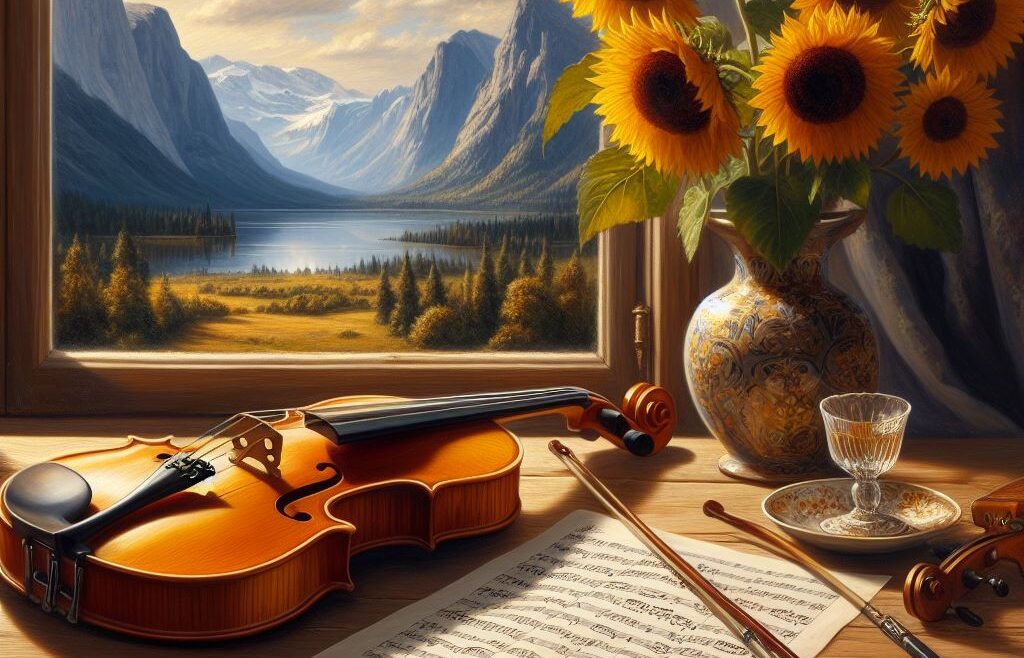
The connection between music and nature is as ancient as the hills, quite literally. From the whispering winds that mimic the soft phrases of a flute to the rhythmic patterns of rain that resemble percussive beats – nature has been a muse for composers across the ages. It’s a fascinating journey to delve into how this elemental source has influenced classical music, resulting in some timeless masterpieces that continue to captivate us.
The Vibrant Colors of Vivaldi’s “Four Seasons”
Antonio Vivaldi’s “The Four Seasons” stands as a vibrant tapestry of nature woven through music. Composed in 1723, these four violin concertos offer a mesmerizing journey through the changing landscapes and moods of the seasons. What distinguishes Vivaldi’s masterpiece is his remarkable ability to encapsulate the essence of each season through intricate melodies and harmonies.
Spring bursts forth with jubilant energy, mirroring the bloom and vitality of the season with lively rhythms and exuberant melodies. Summer emerges with a blend of sultry warmth and tempestuous storms, reflecting the season’s volatile temperament. Autumn dances gracefully onto the scene, celebrating the abundance of harvests with spirited melodies and rhythmic motifs. Finally, Winter descends with chilling winds and a serene, at times melancholic, atmosphere, evoking the stark beauty of the season’s icy grip.
Vivaldi’s genius lies not only in his musical craftsmanship but also in his pioneering exploration of program music – compositions designed to evoke specific images or narratives. Through “The Four Seasons,” Vivaldi invites listeners to embark on a sensory journey through the natural world, where music becomes a vibrant canvas painted with the colors and textures of each season’s essence.
More than two centuries after its creation, “The Four Seasons” remains a timeless testament to Vivaldi’s mastery and a perennial favorite among audiences worldwide. Its enduring popularity attests to the enduring power of music to capture the beauty and majesty of the world that surrounds us.
Beethoven’s Love Affair with Nature in the “Pastoral Symphony”
Ludwig van Beethoven, a towering figure in classical music, revealed his profound reverence for nature through his Sixth Symphony, famously known as the “Pastoral Symphony.” Unlike the tumultuous and stormy compositions for which Beethoven is renowned, the “Pastoral Symphony” serves as a tender homage to the serenity and splendor of the countryside. It transcends mere musical notes, inviting listeners on an auditory journey through verdant fields, alongside meandering streams, under the vast expanse of a clear sky.
In this symphony, Beethoven dismantles the barrier between the audience and the natural world, interweaving sounds reminiscent of a tranquil landscape – the gentle babbling of brooks, the whispering of leaves in the breeze, and the distant melodies of a shepherd’s flute. Beyond being a mere depiction of nature’s beauty, the “Pastoral Symphony” stands as a testament to Beethoven’s profound connection with his surroundings. Indeed, the composer often sought solace and inspiration during solitary walks through the Vienna woods, finding solace and renewal amidst the embrace of nature.
Through the “Pastoral Symphony,” Beethoven invites listeners to share in his intimate communion with the natural world, offering a glimpse into the tranquility and wonder that he found amidst the serene landscapes that surrounded him. As the music unfolds, it evokes not only the external splendor of nature but also the profound sense of peace and harmony that arises from the union of humanity and the environment.
Debussy and the Impressionistic Landscapes
Claude Debussy, often hailed as a pioneer of Impressionistic music, infused his compositions with a profound sensitivity to the natural world. Works such as “La mer” transcend mere depictions of the sea, presenting it as a dynamic, living entity teeming with mystery and grandeur. Debussy’s music eschews literal representation, instead capturing the ephemeral sensations and impressions evoked by nature’s ever-shifting essence.
In “Prelude to the Afternoon of a Faun,” listeners are transported to a realm of dreamy enchantment where the boundaries between reality, myth, and emotion blur effortlessly. Here, nature intertwines with mythical beings, weaving a tapestry of sound that evokes a sense of timeless wonder and fascination.
Debussy’s genius lies in his ability to transcend the confines of traditional musical forms, crafting compositions that resonate with the essence of nature’s allure. Through his works, he invites audiences to explore the depths of imagination and emotion, inviting them on a journey through landscapes both tangible and ethereal.
The Rustic Charm of Copland’s “Appalachian Spring”
Aaron Copland’s “Appalachian Spring” offers a distinctly American portrayal of the harmonious relationship between music and nature. Originally commissioned for a ballet, this composition encapsulates the essence of the American frontier – expansive landscapes, pioneering spirits, and a profound reverence for the land.
In crafting “Appalachian Spring,” Copland skillfully integrates traditional folk melodies and a sense of spaciousness that mirrors the vastness and beauty of the American landscape. The composition’s open, uncluttered harmonies and gently flowing melodies evoke vivid imagery of the Appalachian Mountains in springtime – a time of renewal, growth, and boundless optimism.
Through “Appalachian Spring,” Copland invites listeners to immerse themselves in the rustic charm and enduring spirit of America’s heartland. The music serves as a celebration of the natural world and the indomitable human spirit, capturing the essence of hope and possibility that permeates the American experience.
With its evocative melodies and rich orchestration, “Appalachian Spring” is a timeless tribute to nature’s enduring beauty and resilience, offering a glimpse into the soul of a nation shaped by its majestic landscapes and pioneering heritage.
The Raw Power of Nature in Stravinsky’s “Rite of Spring”
While many composers have sought to capture the beauty and tranquility of nature, Igor Stravinsky’s “Rite of Spring” explores its raw, primordial aspects. This groundbreaking work’s premiere in 1913 famously caused a riot, and it’s easy to see why – Stravinsky’s music was unlike anything heard before, with its dissonant harmonies, complex rhythms, and sheer unpredictability.
“Rite of Spring” portrays nature not as serene and picturesque but as a powerful, sometimes violent force that commands awe and respect. It’s a stark reminder of the untamed, unpredictable aspects of the natural world, and its influence on modern music cannot be overstated.
_______________________________________________________________________
Throughout history, composers have turned to nature for inspiration, resulting in an array of masterpieces that continue to enchant and move audiences. From Vivaldi’s lush landscapes to Beethoven’s pastoral idylls, Debussy’s impressionistic seascapes, and Copland’s American vistas these compositions underscore music’s profound ability to capture the essence of the world around us.
Whether through striking mimicry or abstract evocation, these works invite us to listen more closely not just to the music itself, but to the natural world that inspires it. They remind us of our deep connection to nature, urging us to seek out and cherish these bonds.
